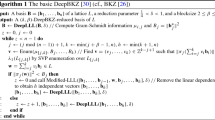Abstract
We present m-SubBKZ reduction algorithm that outputs a reduced lattice basis, containing a vector shorter than the original BKZ. The work is based on the properties of sublattices and the Gaussian Heuristic of the full lattice and sublattices. By theoretical analysis and simulation, we suggest a BKZ call on the sublattice is possible to produce a short vector close to the shortest vector in the full lattice. The key idea of our algorithm is to extract multiple sublattices from the preprocessed lattice, restricting the context in which a lattice reduction solver is called. The full basis is then updated with vectors from the reduced basis of each sublattice. The new algorithm improves on the efficiency of the original BKZ algorithm and the BKZ 2.0 variant. We show the experimental results on random lattices to compare the length of vectors produced by our algorithm and original BKZ and BKZ 2.0. On the 180-dimension basis, the m-SubBKZ reaches 47% of the output of BKZ and 46% of BKZ 2.0. The ratio drops with the dimension increasing. The effect is more oblivious with smaller blocks. The results show that the new algorithm is able to produce a shorter vector at a relatively low cost compared with previous algorithms, and the improvements are especially explicit for lattices of high dimensions.
Access this chapter
Tax calculation will be finalised at checkout
Purchases are for personal use only
Similar content being viewed by others
References
Schnorr, C.P., Euchner, M.: Lattice basis reduction: improved practical algorithms and solving subset sum problems. Math. Program. 66, 181–199 (1994)
Nguyen, P.Q., Vidick, T.: Sieve algorithms for the shortest vector problem are practical. J. Math. Cryptol. 2(2), 181–207 (2008)
Micciancio, D., Voulgaris, P.: Faster exponential time algorithms for the shortest vector problem. In: 21st Annual ACM-SIAM Symposium on Discrete Algorithms, pp. 1468–1480. ACM-SIAM, Austin (2010)
Ducas, L.: Shortest vector from lattice sieving: A few dimensions for free. In: EUROCRYPT 2018, Part I, LNCS, vol. 10820, pp. 125–145. Springer, Cham (2018). https://doi.org/10.1007/978-3-319-78381-9_5
Lenstra, A.K., Lenstra, H.W., Lovász, L.: Factoring polynomials with rational coefficients. Math. Annalen 261, 515–534 (1982)
Aggarwal, D., Li, J., Nguyen, P.Q., Stephens-Davidowitz, N.: Slide reduction, revisited - filling the gaps in SVP approximation. In: Advances in Cryptology - CRYPTO 2020, LNCS, vol. 12171, pp. 274–295. Springer, Cham (2020). https://doi.org/10.1007/978-3-030-56880-1_10
Chen, Y., Nguyen, P.Q.: BKZ 2.0: Better lattice security estimates. In: ASIACRYPT 2011, LNCS, vol. 7073, pp. 1–20. Springer, Heidelberg (2011). https://doi.org/10.1007/978-3-642-25385-0_1
Aono, Y., Wang, Y., Hayashi, T., Takagi, T.: Improved progressive BKZ algorithms and their precise cost estimation by sharp simulator. In: Advances in Cryptology - EUROCRYPT 2016, LNCS, vol. 9665, pp. 789–819. Springer, Heidelberg (2016). https://doi.org/10.1007/978-3-662-49890-3_30
Albrecht, M., Bai, S., Fouque, P.A., Kirchner, P., Stehle, D., Wen, W.: Faster enumeration-based lattice reduction : root hermite factor k1/(2k) time kk/8+o(k). In: Advances in Cryptology - CRYPTO 2020. LNCS, vol. 12171, pp. 186–212. Springer, Cham (2020). https://doi.org/10.1007/978-3-030-56880-1_7
Nguyen, P.Q., Vallee, B.: The LLL Algorithm, Survey and Applications, 1st edn. Springer, Heidelberg (2010). https://doi.org/10.1007/978-3-642-02295-1
Micciancio, D., Walter, M.: Practical, predictable lattice basis reduction. In: Advances in Cryptology - EUROCRYPT 2016, LNCS, vol. 9665, pp. 820–849. Springer, Heidelberg (2016). https://doi.org/10.1007/978-3-662-49890-3_31
Schnorr, C.P.: Lattice reduction by random sampling and birthday methods. In: STACS 2003, LNCS, vol. 2607, pp. 145–156. Springer, Heidelberg (2003). https://doi.org/10.1007/3-540-36494-3_14
Guillaume, H., Pujol, X., Stehle, D.: Analyzing blockwise lattice algorithms using dynamical systems. In: Advances in Cryptology - CRYPTO 2011, LNCS, vol. 6841, pp. 447–464. Springer, Heidelberg (2011). https://doi.org/10.1007/978-3-642-22792-9_25
Gama, N., Nguyen, P.Q.: Finding short lattice vectors within Mordell’s inequality. In: 40th ACM STOC, pp. 207–216. ACM Press, Columbia (2008)
The FPLLL development team. FPLLL, a lattice reduction library. https://github.com/fplll/fplll. Accessed 25 May 2021
The FPLLL development team. FPyLLL, a Python interface to fplll. https://github.com/fplll/fpylll. Accessed 25 May 2021
Acknowledgement
The authors would like to thank the anonymous reviewers for their valuable comments. This work was supported by the National Natural Science Foundation of China (No. 61872449, 62032009) and the National Key Research and Development Program of China (No. 2018YFA0704705).
Author information
Authors and Affiliations
Corresponding author
Editor information
Editors and Affiliations
Rights and permissions
Copyright information
© 2021 Springer Nature Switzerland AG
About this paper
Cite this paper
Cao, J., Pan, Y., Cheng, Q. (2021). A Lattice Reduction Algorithm Based on Sublattice BKZ. In: Huang, Q., Yu, Y. (eds) Provable and Practical Security. ProvSec 2021. Lecture Notes in Computer Science(), vol 13059. Springer, Cham. https://doi.org/10.1007/978-3-030-90402-9_10
Download citation
DOI: https://doi.org/10.1007/978-3-030-90402-9_10
Published:
Publisher Name: Springer, Cham
Print ISBN: 978-3-030-90401-2
Online ISBN: 978-3-030-90402-9
eBook Packages: Computer ScienceComputer Science (R0)




